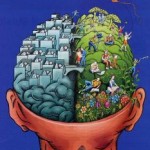Life sciences marketing: the two brains revisited
No doubt you — like millions of others — are an avid follower of my posts on this site. Cast your memory back about a year ago. In “Feeding the thing with two brains,” I blogged about the attraction to life sciences marketing, likening it to balancing the “needs” of the two sides of the brain — the rational and the emotional. Well, now I’m writing about another aspect of this field that continues to fascinate: the potential to learn something new — or unlearn a “fact” you have known forever.
Imagine my amazement when I viewed a presentation via TED of an RSA Animate talk given by noted psychiatrist, author and brain expert Iain McGilchrist. In this artfully animated talk, he disposes of the old paradigm I quoted in my previous post: “The right brain is the seat of all that is rationale, and the left brain is the seat of the emotions.”













